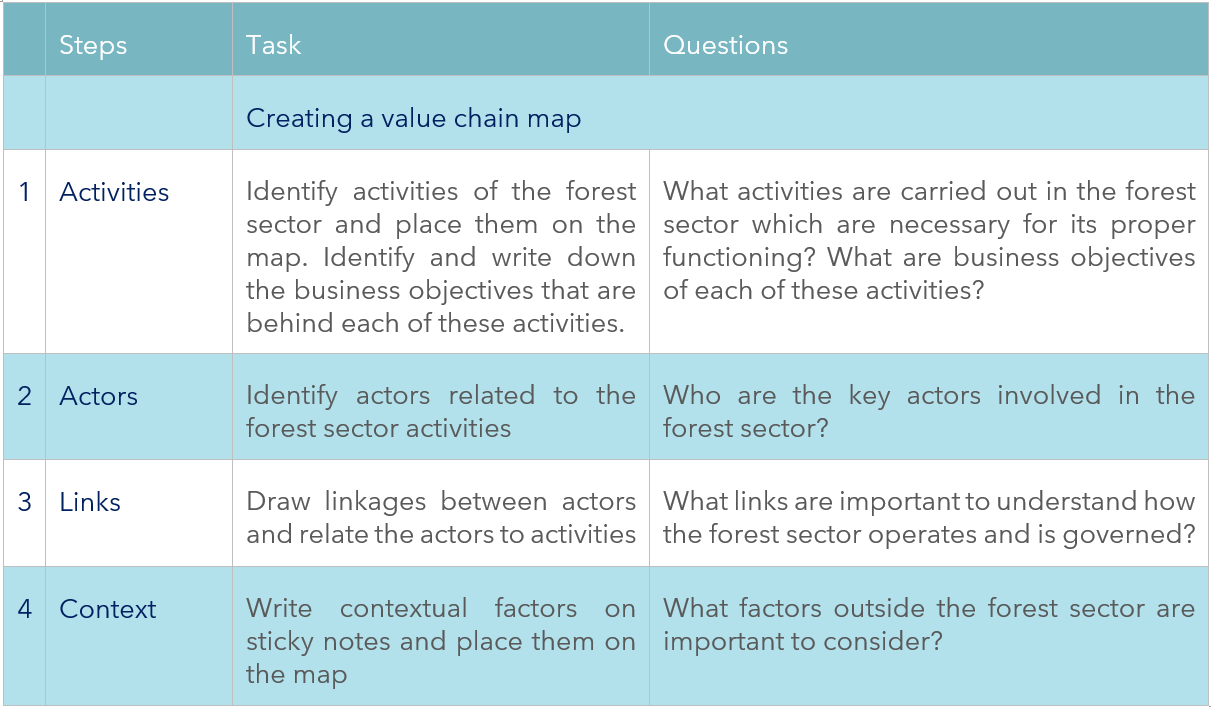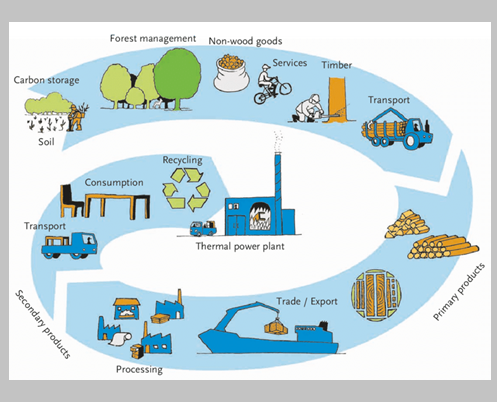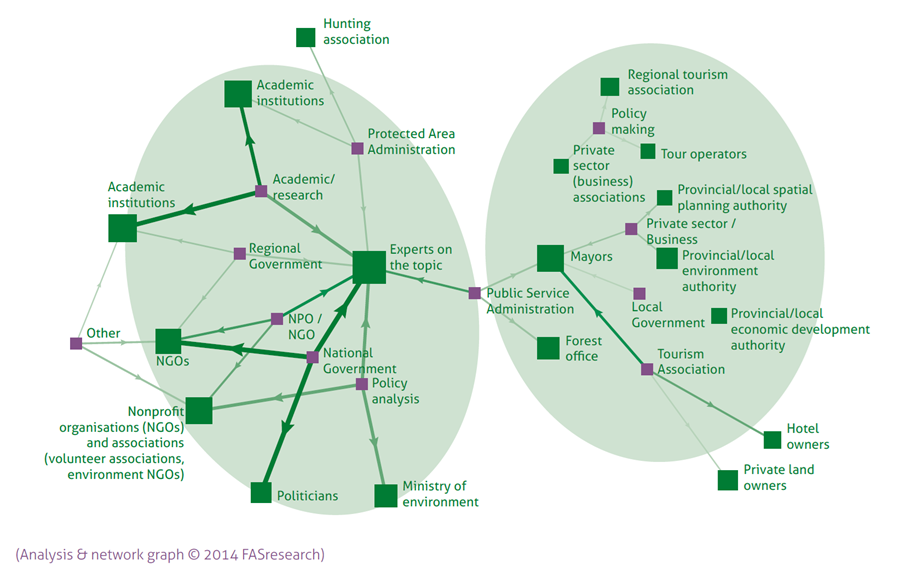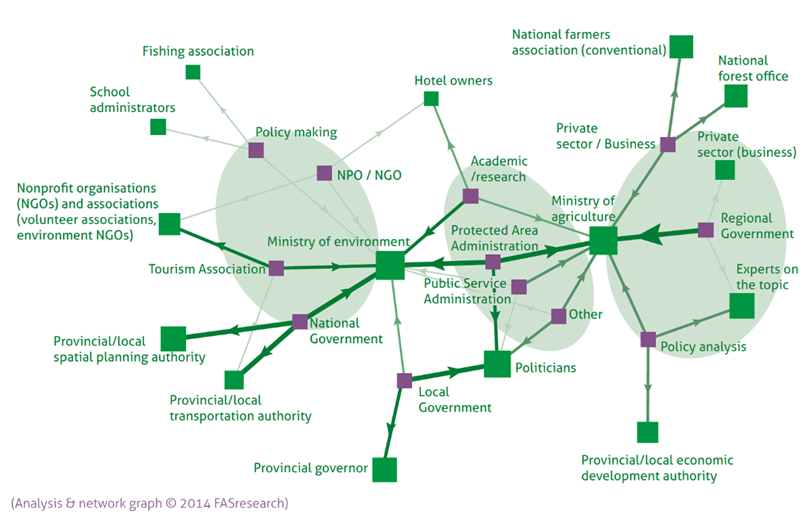Phase 1: Alignment of IT with business
Understand organizational context
Objective of the exercise
The objective of this exercise is to analyse how the forest sector is organized, what linkages and dependencies exist between various stakeholders and how they contribute to create added value in the forest sector. These outputs will be used later for determining needs and opportunities for improvements through the development of an FIS.
Introduction
What is a value chain analysis?
Value chain analysis (VCA) is a frequently employed technique, especially in large-scale programmes, to develop an understanding of how activities and actors that are involved in bringing a product from production to consumption are linked. A value chain is understood here as the set of activities through which actors get increased value from products or services. “There is a simple element at the heart of value chain analysis. The idea of a chain is a metaphor for connectivity. It highlights the point that most goods and services are produced by a complex and sequenced set of activities”(Humphrey and Navas-Alemán 2010).
Why is value chain analysis important in FIS development?
A FIS is always embedded in a larger network of activities, which create relationships and constraints that have to be addressed and opportunities that can be exploited. Mapping of the value chain in which the FIS will be placed helps to identify (i) existing components, (ii) actors, (iii) activities, and (iv) linkages – both vertical and horizontal, and thus facilitates later a structured discussion about these opportunities, constraints and possible optimal solutions(Stein and Barron 2017).
What methods are used in value chain analysis?
The range of methods that are commonly used for researching value chains are:
- Desk studies;
- Interviews;
- Focus group discussions;
- Surveys;
- Document analysis; and
- Participatory observations.
As there is not a single, universally applicable method for studying value chains, usually a combination of them is used. However, the analysis should focus on the organizational context, not on details of particular elements of the value chain structure and/or their performance.
What are the steps of organizational context analysis?
The following are the steps of organizational context analysis:
- Identify activities in the forest sector and business objectives behind them.
- Identify actors related to the forest sector activities.
- Establish linkages between the actors and relate the actors to the activities.
- Add contextual notes.
If the scope of the digital transformation programme is limited to a single part of the value chain or a single organization, the organizational context analysis may be simplified.

Step 1. Identify activities in the forest sector and business objectives behind them
The exercise starts with brainstorming on the type of activities carried out in the forest sector (or part of it, depending on the analysis scope) which are necessary for its functioning. Create a list of these activities.
Practical note: Names of activities should be written on sticky notes and placed on a whiteboard.
While listing activities, business objectives should be assigned to each activity. Business objectives are the measurable results that are aimed to be achieved by carrying out a specific activity in order to accomplish a longer-term vision.
Practical note: Business objectives should be written on sticky notes and placed next to the appropriate activities.
Step 2. Identify actors related to the forest sector activities
Using the results of the institutional mapping exercise, key actors involved in the forest sector should be identified. It is likely that additional activities and business objectives will appear. In this case, the results of step 1 should be updated, too.
Practical note: Names of actors should be written on sticky notes and placed next to the appropriate activities/business objectives.

Step 3. Establish linkages between the actors and relate the actors to the activities.
Once necessary objects have been identified, their linkages and dependencies should be analysed. The focus should be on those links that are important to understand how the forest sector operates and is governed. Those of marginal importance should be omitted. It is important to add descriptions of how and why the two objects are connected.

From a practical point of view, it is usually beneficial to present the linkages between the institutional stakeholders in the form of a graph. The actual approach should be aligned with the content and objectives of the analysis.
Practical note: The sticky notes that have been created in the previous steps should be clustered around related ones, leaving enough space for drawing links and placing other notes. Then appropriate links should be drawn. In case of mistakes or need to improve the object placement, the link should be erased, and the analysis started again.

It is beneficial to create two separate maps/graphs, presenting connections between stakeholders

and a network diagram of perceived stakeholder impact on other stakeholders

An alternative approach could be to visualize both linkages and influences in a single diagram:
An example of stakeholder mapping of the forest sector in Poland is presented in

Step 4. Add contextual notes
In the context of developing and implementing forest information systems, adding contextual notes is a crucial step in the organizational context analysis. Contextual notes provide relevant information and insights about the actors, activities, and linkages identified in the previous steps. These notes help in understanding the broader context within which the forest sector operates, enabling better decision-making and effective system design.
Practical note: To add contextual notes effectively, it is necessary to conduct interviews, surveys and research to gather comprehensive information about the forest sector and the actors involved. This should include socioeconomic factors, environmental considerations, regulatory frameworks, technological advancements and any other relevant contextual details. Additionally, perspectives and expectations of stakeholders should be considered to gain a well-rounded understanding.